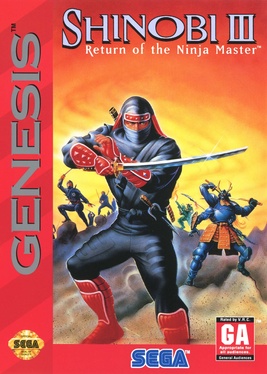
Shinobi III: Return of the Ninja Master, released in Japan as The Super Shinobi II, is a 1993 hack-and-slash platform game developed and published by Sega for the Mega Drive/Genesis. It is the direct sequel to the previous The Revenge of Shinobi. The game was intended to be released in 1992 and to be very different from the final version of the game in terms of levels and storyline. Shinobi III received critical acclaim. It's been ranked among the greatest Mega Drive/Genesis games.
Super Smash Bros. is a crossover platform fighting game series published by Nintendo. The series was created by Masahiro Sakurai, who has directed every game in the series. The series is known for its unique gameplay objective which differs from that of traditional fighters, in that the aim is to increase damage counters and knock opponents off the stage instead of depleting life bars.
The Virtual Console is a line of downloadable video games for Nintendo's Wii and Wii U home video game consoles and the Nintendo 3DS family of systems.

A Mii is a customizable avatar used on several Nintendo video game consoles and mobile apps. The name Mii is a portmanteau of "Wii" and "me", referring to them typically being avatars of the players. Miis were first introduced on the Wii console in 2006 and later appeared on the DS, 3DS, the Wii U, the Switch, and various apps for smart devices such as Miitomo. Miis can be created using different body, facial and clothing features, and can then be used as characters within games on the consoles, either as an avatar of a specific player or in some games portrayed as characters with their own personalities. Miis can be shared and transferred between consoles, either manually or automatically with other users over the internet and local wireless communications.

Trollface or Troll Face is a rage comic meme image of a character wearing a mischievous smile, used to symbolise internet trolls and trolling. It is one of the oldest and most widely known rage comic faces.
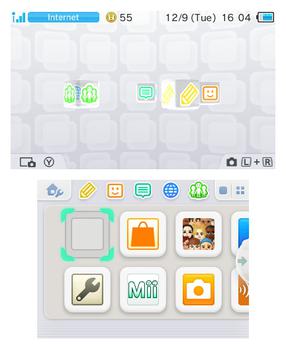
The Nintendo 3DS system software is the updatable operating system used by the Nintendo 3DS handheld system. The Nintendo Switch system software is believed to have evolved from the Nintendo 3DS system software.
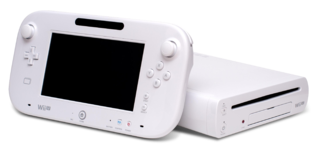
The Wii U is a home video game console developed by Nintendo as the successor to the Wii. Released in late 2012, it is the first eighth-generation video game console and competed with Microsoft's Xbox One and Sony's PlayStation 4.
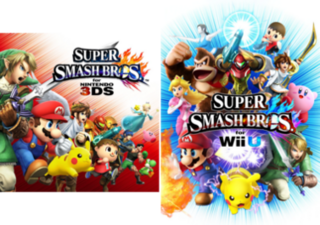
Super Smash Bros. for Nintendo 3DS and Super Smash Bros. for Wii U, both commonly referred together as Super Smash Bros. 4, are 2014 crossover platform fighter video games developed by Bandai Namco Studios and Sora Ltd. and published by Nintendo for the Nintendo 3DS and Wii U video game consoles. It is the fourth installment in the Super Smash Bros. series, succeeding Super Smash Bros. Brawl. The Nintendo 3DS version was released in Japan on September 13, 2014, and in North America, Europe, and Australia the following month. The Wii U version was released in North America, Europe, and Australia in November 2014 and in Japan the following month.
The Nintendo Network is Nintendo's soon-to-be defunct online service which provides online functionality for the Nintendo 3DS and Wii U systems and their compatible games. Announced on January 26, 2012, at an investors' conference, it is Nintendo's second online service after Nintendo Wi-Fi Connection. Former president of Nintendo Satoru Iwata said, "Unlike Nintendo Wi-Fi Connection, which has been focused upon specific functionalities and concepts, we are aiming to establish a platform where various services available through the network for our consumers shall be connected via Nintendo Network service so that the company can make comprehensive proposals to consumers."
Art Academy is a series of edutainment video games beginning in 2009 with Art Academy. Its most recent release was Disney Art Academy. One of Nintendo's franchises, the series has been released on Nintendo DS, Nintendo 3DS and Wii U.

Miiverse is a discontinued social network for Nintendo 3DS and Wii U that was created by Nintendo System Development and Hatena, and powered by the Nintendo Network. Integrated into many games, Miiverse allowed players to interact and share their experiences by way of handwritten messages or drawings, text, screenshots, and sometimes game videos in dedicated communities. It was available via any web browser, and a dedicated app version was originally planned for tablets and smartphones. All users who signed up for a Nintendo Network ID were automatically given a Miiverse profile per account, represented by the Mii avatar connected to said Nintendo Network ID.
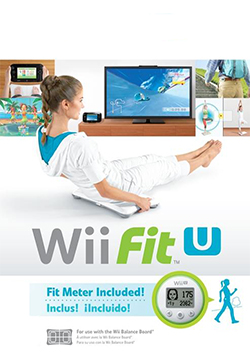
Wii Fit U is an exergaming video game developed by Nintendo for the Wii U console, and is the successor to the Wii games Wii Fit and Wii Fit Plus. Wii Fit U utilizes both the Wii Balance Board and the Wii U GamePad in gameplay, and is bundled with the newly introduced Fit Meter, an activity meter accessory. It was released in Japan on October 31, 2013, followed by North America and Europe one day later. It is also the only game on the system to support the balance board.

The Wii U system software is the official firmware version and operating system for Nintendo's Wii U home video game console. Nintendo maintains the Wii U's systemwide features and applications by offering system software updates via the Internet. Updates are optional to each console owner, but may be required in order to retain interoperability with Nintendo's online services. Each update is cumulative, including all changes from previous updates.

Animal Crossing Plaza was a free to play social networking service developed and published by Nintendo for the Wii U. A spin-off of Animal Crossing: New Leaf of the Animal Crossing series, Plaza was released as a tie-in to Miiverse, Nintendo's now-defunct social networking service. The application is no longer actively supported by Nintendo, and was removed from the Nintendo eShop on December 22, 2014.
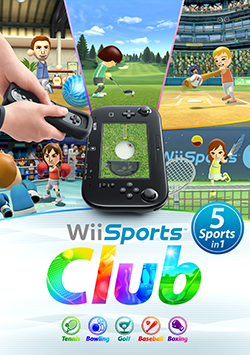
Wii Sports Club is a sports simulation video game, developed by Nintendo and Bandai Namco Studios and published by Nintendo for the Wii U throughout 2013 and 2014. It is the third entry in the Wii Sports series, a part of the larger Wii series. As an enhanced remake of the 2006 Wii launch title Wii Sports, it includes five minigames that replicate Tennis, Baseball, Bowling, Golf, and Boxing, and are controlled with motion controls that replicate the sports. New to the game is additional control schemes using the Wii U GamePad, online multiplayer, and Wii Motion Plus support. Players are organized into clubs that represent different regions, and scores and stats are tracked on Nintendo's social network Miiverse. Players could also communicate with each other during and after online matches using Miiverse. Each sport can be purchased individually or rented for a certain amount of time via a pass.

Pushmo World, known as Pullblox World in Europe and Australia and as Hikuosu World in Japan, is a puzzle game developed by Intelligent Systems and published by Nintendo for the Wii U video game console. The game is the sequel to Pushmo and Crashmo, and was released worldwide on June 19, 2014. A sequel, Stretchmo for the Nintendo 3DS, was released in 2015.
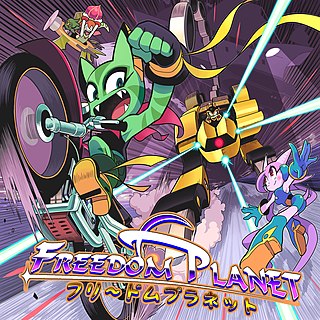
Freedom Planet is a 2014 platform game developed and published by American video game designer Sabrina DiDuro, for her studio GalaxyTrail. The player controls one of three anthropomorphic animal protagonists: the dragon girl Lilac, the wildcat Carol, or the basset hound Milla. Aided by a duck-like alien named Torque, the girls attempt to defeat the evil Lord Brevon, who plans to steal the Kingdom Stone and conquer the galaxy. While the game focuses on fast-paced platforming, its levels are interspersed with slower action scenes.
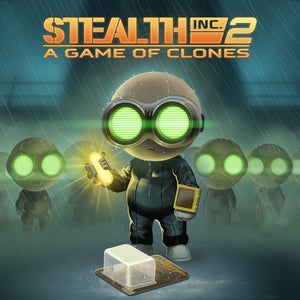
Stealth Inc 2: A Game of Clones is a 2D puzzle platform video game which was developed and published by Curve Digital. The game is a sequel to Stealth Bastard Deluxe, featuring different mechanics which involve puzzle sections. The game was released for the Wii U on October 23, 2014. The PlayStation 3, PlayStation 4, PlayStation Vita, Xbox One and Microsoft Windows versions of the game were also released in April 2015.

Mario vs. Donkey Kong: Tipping Stars is a puzzle video game developed by Nintendo Software Technology and published by Nintendo for the Nintendo 3DS and Wii U. It is the sixth game in the Mario vs. Donkey Kong series, succeeding Mini-Land Mayhem and Minis on the Move, and the 200th ever video game featuring Mario. The title was released worldwide in March 2015 on the Nintendo eShop for all regions, except in Japan. This is the first Nintendo-published title to support a cross-purchase concept, and the first Nintendo 3DS title to support Miiverse stamps. If players buy one version, they receive a free download code for the other version.

Mario & Sonic at the Rio 2016 Olympic Games is a 2016 crossover sports and party game in the Mario & Sonic at the Olympic Games series, released for the Nintendo 3DS in February 2016 in Japan, March 2016 in North America, and in April 2016 for Europe and Australia, and for the Wii U worldwide in June 2016. The game is officially licensed by the International Olympic Committee, as are the other games in the series. It was developed by Sega, with assistance from Arzest and Spike Chunsoft, and published by Nintendo. It is the fifth title in the Mario & Sonic at the Olympic Games series. The game is a collection of Olympic sports themed mini-games featuring characters from the Mario series and the Sonic the Hedgehog series.
















